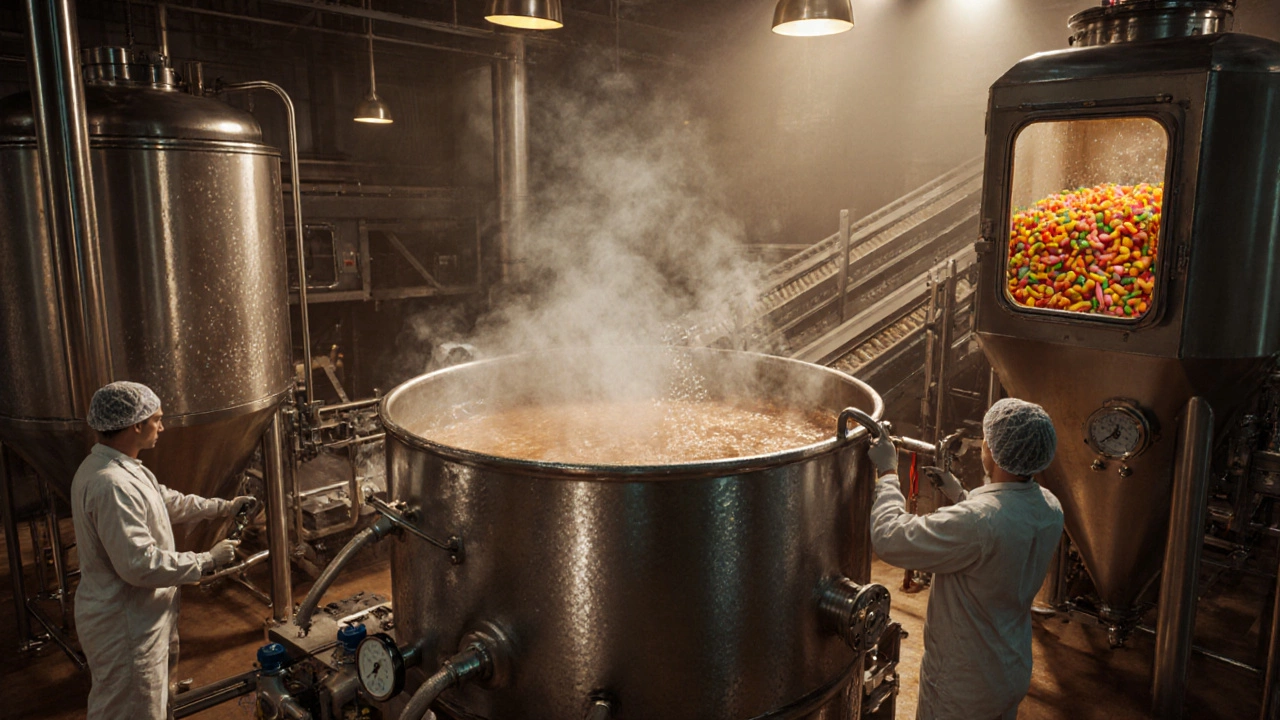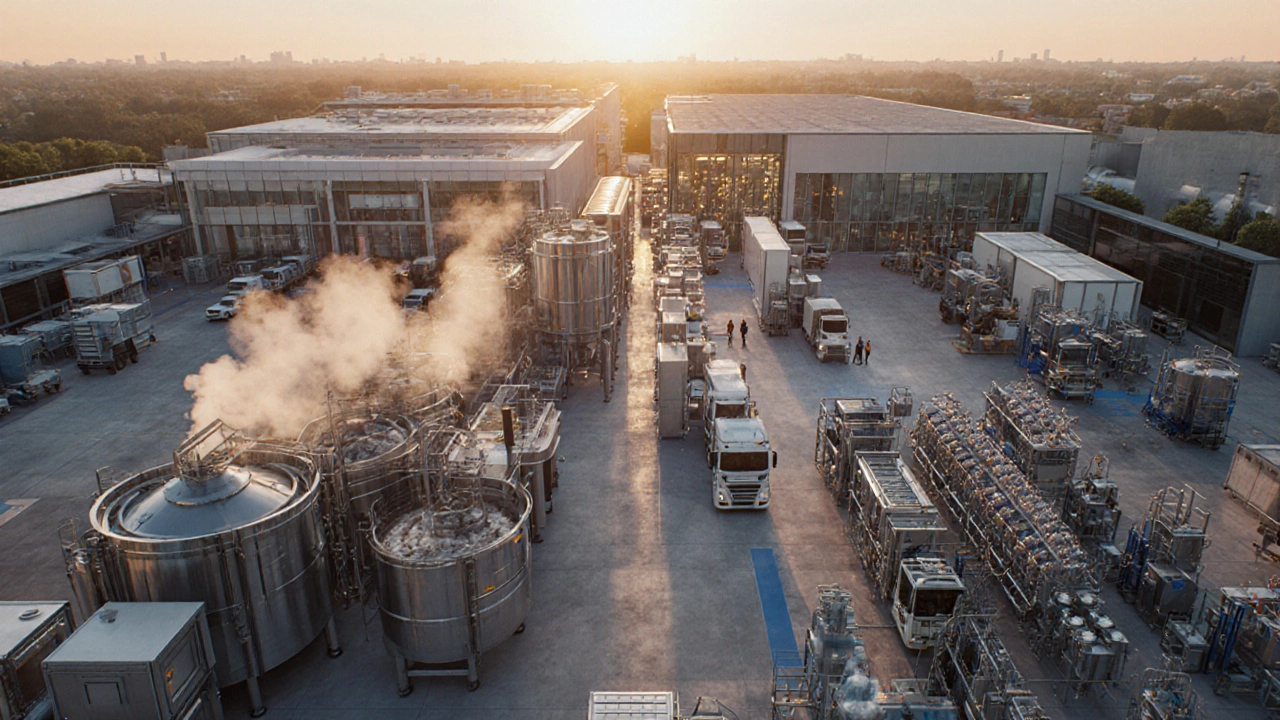Food Industry Units Explorer
Core Function: Convert raw ingredients into food product
KPI: Yield %
Equipment: Steam kettles, extruders, fermenters
Companies: Nestlé, Kraft
Core Function: Protect and brand finished product
KPI: Line speed (units/min)
Equipment: Flow-wrap, aseptic fillers
Companies: Tetra Pak, Amcor
Core Function: Move product to market efficiently
KPI: On-time delivery %
Equipment: WMS, refrigerated trucks
Companies: DB Schenker, DHL
Core Function: Ensure safety and quality
KPI: Defect rate
Equipment: Spectrophotometer, microbiology labs
Companies: SGS, Eurofins
Core Function: Develop new products & processes
KPI: Patents / new SKUs
Equipment: Pilot plant, sensory labs
Companies: Unilever, Danone
Core Function: Drive revenue and brand equity
KPI: Market-share growth
Equipment: Analytics platforms, CRM
Companies: PepsiCo, Mondelez
Core Function: Maintain legal conformity
KPI: Audit pass rate
Equipment: HACCP software, traceability tools
Companies: Food Standards Australia, FDA
Interactive Guide Summary
Each food industry unit plays a vital role in transforming raw ingredients into market-ready products. Understanding how they work together helps businesses make strategic decisions about operations, investments, and growth.
Tip: Hover over each card to see enhanced details. Click on any unit to learn more about its specific function and importance.
Key Takeaway
Successful food businesses integrate all units seamlessly. Siloed operations often lead to inefficiencies and quality issues. Consider how each unit supports others in your overall strategy.
TL;DR
- Food industry units are functional groups like processing, packaging, distribution, R&D, QC, and sales that keep the supply chain moving.
- Each unit has a core purpose, key performance indicators, and typical equipment.
- Understanding these units helps you plan a new plant, optimise an existing line, or choose a career path.
- Use the checklist at the end to decide which units matter most for your business model.
- FAQs cover common follow‑up questions about staffing, regulation and technology trends.
What Do We Mean by food industry units?
When we talk about Food industry units the distinct functional sections that together turn raw ingredients into a market‑ready product and deliver it to consumers, we’re not describing physical measurement units. Instead, a "unit" is a business‑oriented division that focuses on a specific set of activities. Think of a car factory: it has body‑shop, paint, and assembly units. A food business mirrors that structure with its own set of units, each with its own goals, equipment, and performance metrics.
Processing Unit
Processing Unit the heart of any food operation where raw materials are transformed through cooking, mixing, extrusion, fermentation or other physical‑chemical processes. Its primary KPI is yield (percentage of usable product from raw input). Typical equipment includes steam kettles, continuous mixers, extruders, and batch reactors. Major food companies such as Nestlé and Kraft operate massive processing units that run 24/7 to meet global demand.
Packaging Unit
Packaging Unit the section that protects, preserves and brands the finished product for distribution. Key performance indicators are line speed (units per minute) and pack integrity rate. Common machinery ranges from flow‑wrap machines for snack bars to aseptic filling lines for dairy. Companies like Tetra Pak specialise entirely in packaging technology, supplying turnkey solutions to food processors.
Distribution & Logistics Unit
Distribution & Logistics Unit the hub that coordinates inbound raw material deliveries and outbound product shipments. Core metrics include on‑time delivery percentage and transportation cost per tonne‑kilometre. This unit often collaborates with 3PL providers and uses warehouse management systems (WMS) to optimise pallet stacking, cold‑chain monitoring, and route planning.
Quality Control & Assurance Unit
Quality Control & Assurance Unit the team that tests raw inputs, monitors in‑process parameters, and validates final products against safety standards. Its main KPI is defect rate (samples that fail specifications). Tools range from spectrophotometers for colour consistency to microbiological incubators for pathogen testing. Regulatory bodies like FSANZ in Australia and the FDA in the US set the compliance framework that this unit follows.
Research & Development (R&D) Unit
R&D Unit the innovation engine that creates new products, improves formulations and explores novel processing techniques. Success is measured by the number of patents filed or new SKU launches per year. Pilot plants, sensory labs, and simulation software are typical assets. Companies like Unilever invest heavily in R&D to keep their portfolio fresh.

Sales & Marketing Unit
Sales & Marketing Unit the outward‑facing group that drives brand awareness, negotiates retailer contracts and monitors market trends. Key metrics include market share growth and revenue per SKU. Modern teams rely on POS data analytics, social media listening tools, and shopper insights platforms.
Regulatory & Compliance Unit
Regulatory & Compliance Unit the specialist area that ensures the entire operation adheres to food safety laws, labeling requirements and export certifications. Its KPI is audit pass rate. This unit often works hand‑in‑hand with QC, providing guidance on HACCP plan updates, allergen controls, and traceability system design.
How the Units Fit Together: A Quick Comparison
| Unit | Core Function | Typical KPI | Key Equipment | Example Companies |
|---|---|---|---|---|
| Processing | Convert raw ingredients into food product | Yield % | Steam kettles, extruders, fermenters | Nestlé, Kraft |
| Packaging | Protect and brand finished product | Line speed (units/min) | Flow‑wrap, aseptic fillers | Tetra Pak, Amcor |
| Distribution & Logistics | Move product to market efficiently | On‑time delivery % | WMS, refrigerated trucks | DB Schenker, DHL |
| QC & QA | Ensure safety and quality | Defect rate | Spectrophotometer, microbiology labs | SGS, Eurofins |
| R&D | Develop new products & processes | Patents / new SKUs | Pilot plant, sensory labs | Unilever, Danone |
| Sales & Marketing | Drive revenue and brand equity | Market‑share growth | Analytics platforms, CRM | PepsiCo, Mondelez |
| Regulatory & Compliance | Maintain legal conformity | Audit pass rate | HACCP software, traceability tools | Food Standards Australia, FDA |
Practical Checklist: Which Units Do You Need?
- Start‑up or boutique producer? Focus on Processing, QC, and a lean Packaging setup. You can outsource Distribution to a local 3PL.
- Scaling to national distribution? Add a dedicated Distribution & Logistics unit, strengthen QC, and invest in a mid‑size Packaging line.
- Launching innovative product lines? Build an R&D unit early; it reduces time‑to‑market and protects IP.
- Operating in heavily regulated markets? The Regulatory & Compliance unit becomes a core pillar; partner closely with QC.
- Looking to boost sales quickly? Expand Sales & Marketing staff, adopt data‑driven tools, and align them with R&D for “trend‑to‑shelf” pipelines.
Common Pitfalls to Avoid
Many new food manufacturers treat units as optional add‑ons. Skipping QC leads to recalls that can cripple a brand. Under‑investing in Logistics causes stock‑outs and higher freight costs. Finally, siloed R&D without market feedback results in products that never sell. A holistic view-treating each unit as a link in the chain-keeps the operation resilient.
Emerging Trends Shaping Units Today
Automation is blurring lines between Processing and Packaging; robotic arms now load trays directly into case‑pack machines. Data analytics are giving QC real‑time dashboards, reducing batch failures by up to 30%. Sustainable packaging is prompting new Packaging units that specialise in biodegradable films. And blockchain is being piloted in Regulatory units to provide tamper‑proof traceability from farm to fork.
Frequently Asked Questions
What is the difference between a processing unit and a packaging unit?
The processing unit transforms raw ingredients into edible product (e.g., cooking, mixing, fermenting). The packaging unit takes that finished product and encloses it for protection, branding and transport. Both are essential, but they use different equipment and have distinct KPIs-yield for processing, line speed and seal integrity for packaging.
Do small food businesses need a dedicated regulatory unit?
Even small producers must comply with food safety laws. Instead of a full‑time unit, many start‑ups outsource compliance audits or use cloud‑based HACCP software. As the business grows, transitioning to an internal regulatory team becomes worthwhile.
How can I measure the performance of my QC unit?
Track defect rate (percentage of samples that fail specifications), number of critical non‑conformities per audit, and average time to resolve a deviation. Benchmark against industry standards-most processors aim for less than 0.5% defect rate.
Is it worth investing in an in‑house R&D unit for a niche snack brand?
If your brand relies on flavor innovation or functional ingredients, an in‑house R&D team can shorten development cycles and protect recipes. For very small operations, partnering with a university lab or a contract R&D service may be more cost‑effective.
What technology helps the distribution unit become more efficient?
Warehouse Management Systems (WMS), route‑optimization algorithms, and real‑time temperature monitoring for cold‑chain products are the big contributors. Integrating these with ERP software enables end‑to‑end visibility.
